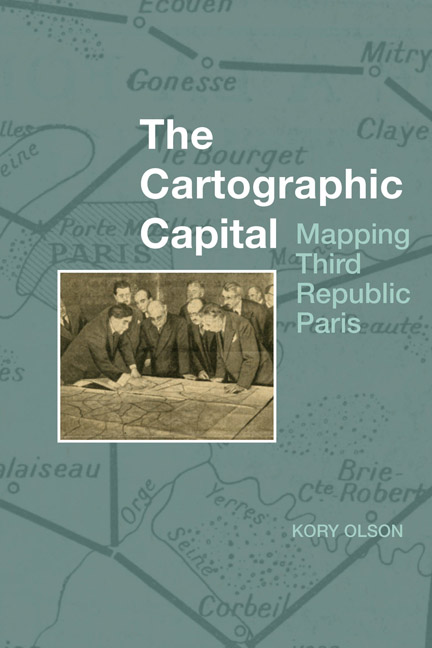Book contents
- Frontmatter
- Contents
- List of Figures
- Acknowledgements
- Introduction: Creating Republican Paris
- 1 Working with Maps
- 2 Creating Map Readers: The Rise of Geography and Cartography in Nineteenth-Century France
- 3 The Triumphant Republic: ‘Paris en 1889, les opérations de voirie exécutées entre 1871 et 1889’
- 4 A New Way of Seeing Paris: The Service Géographique's Carte de France
- 5 The Beginning of French Urbanism: Léon Jaussely's 1919 Plan d'extension
- 6 The Rise of Suburban Paris: Henri Prost's Carte générale
- Conclusion
- Bibliography
- Index
6 - The Rise of Suburban Paris: Henri Prost's Carte générale
- Frontmatter
- Contents
- List of Figures
- Acknowledgements
- Introduction: Creating Republican Paris
- 1 Working with Maps
- 2 Creating Map Readers: The Rise of Geography and Cartography in Nineteenth-Century France
- 3 The Triumphant Republic: ‘Paris en 1889, les opérations de voirie exécutées entre 1871 et 1889’
- 4 A New Way of Seeing Paris: The Service Géographique's Carte de France
- 5 The Beginning of French Urbanism: Léon Jaussely's 1919 Plan d'extension
- 6 The Rise of Suburban Paris: Henri Prost's Carte générale
- Conclusion
- Bibliography
- Index
Summary
Cette oeuvre est vôtre. C'est vous qui l'avez imaginée, c'est vous qui l'avez créée, c'est vous qui l'avez mise en train, en instituant notre comité, il y a six ans, le 28 mars 1928. Par une sorte de justice distributive, bien rare, en politique, c'est à vous que revient l'honneur mais aussi la lourde tâche de la poursuivre. Si, grâce à votre haute autorité, les Chambres réalisent toute la portée et toutes les conséquences de la loi qu'elles ont votée en 1932, elles sauront la compléter et en assurer jusqu'au bout l'exécution. Le comité supérieur, fidèle à son mandat, leur en apporte par votre intermédiaire, dans les délais légaux, les moyens techniques et juridiques. Au Parlement de faire le reste. Vous aurez ainsi, monsieur le président, attaché à jamais votre nom à la plus grande entreprise d'urbanisme national.
—Louis Dausset président du comité supérieur de l'aménagement et de l'organisation général de la région parisienne à M. Albert Sarraut, Président du Conseil des ministre français, Ministre de l'Intérieur, le 15 mai 1934One Sunday afternoon in 1928, Raymond Poincaré, the Président du Conseil des Ministres (Prime Minister), returned from a weekend at his property at Sampigny in the Lorraine region. The weather was beautiful and the trip was going smoothly until he arrived at Chelles, on the eastern outskirts of Paris. There, he found himself behind a long line of cars. An automobile accident ahead had closed a portion of the highway and Poincaré, unable to move, encountered first-hand the realities of unregulated Parisian sprawl. From his car window, he witnessed, ‘une banlieue interminable, sans ossature, où le hasard seul semblait offrir un passage, [avec des] habitations noyées dans un indescriptible chaos’ (Remaury 146). The narrow streets and substandard construction, reminiscent of pre-Haussmann Paris, seemed to startle him. Once back in the city, moved by what he saw, Poincaré suggested a formal region-wide planning authority to normalize not only suburban housing construction, but also the increasingly over-burdened road network outside Paris's city limits.
Six years later, on 14 May 1934, French urbanist Henri Prost presented Albert Sarraut, Minister of the Interior, with his ‘grand album contenant le projet d'aménagement de la région parisienne (Plan Prost),’ a dossier with his detailed plan for Paris's future (Remaury 152).
- Type
- Chapter
- Information
- The Cartographic CapitalMapping Third Republic Paris, 1889-1934, pp. 221 - 267Publisher: Liverpool University PressPrint publication year: 2018



